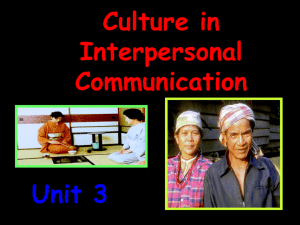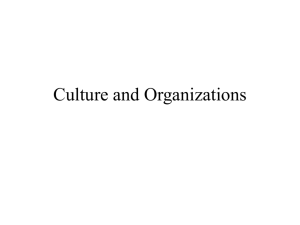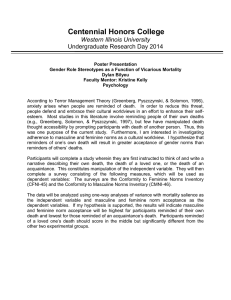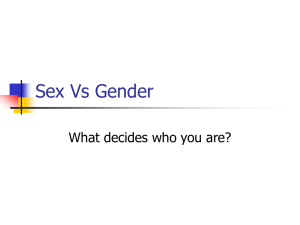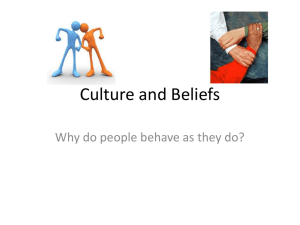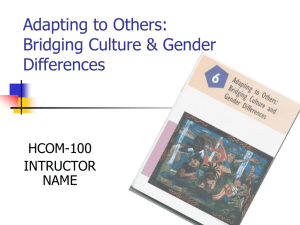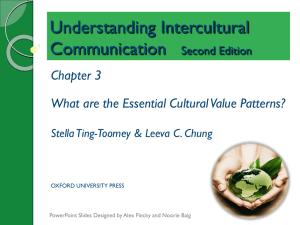Culture - The Business Community
advertisement
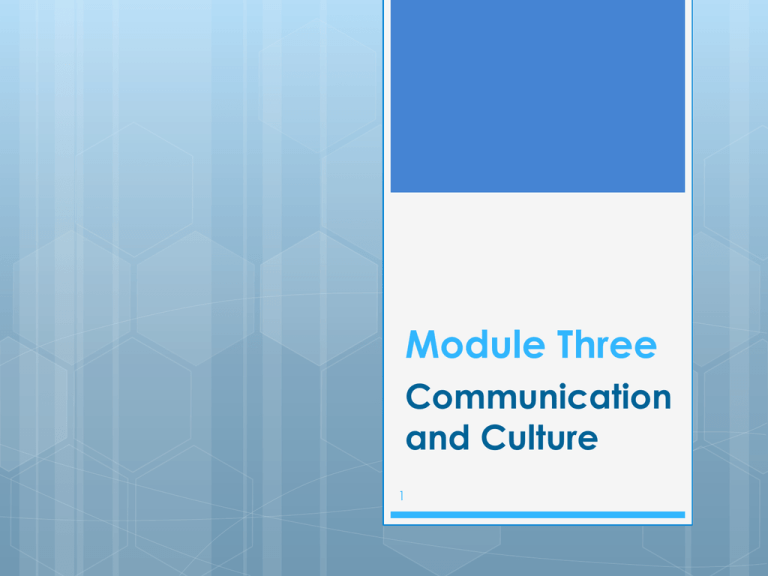
Module Three Communication and Culture 1 2 Culture: the lifestyle of a group of people Culture: a learned set of shared interpretations about beliefs, values, and norms which affect the behaviours of a relatively large group of people. Co-cultures: coexist within the mainstream society yet remain connected to one another. 3 Culture o o o o o values beliefs artifacts ways of behaving ways of communicating o o o o o language ways of thinking art laws religion 4 Intercultural Communication the process of learning one’s culture from one generation to another Enculturation: the process by which a person’s culture is modified through direct contact with or exposure to another culture Acculturation: Intercultural Communication: between people of different cultures; influenced by enculturation and acculturation which can create barriers 5 Your Turn Complete Test Yourself: How Ethnocentric Are You? In your EZ Guide We all tend to see others and their behaviours through our own cultural filters and think our culture is better than other cultures in every way. Ethnocentrism 6 7 Barriers to Understanding Each Other Stereotypes: generalizations about a group of people that oversimplify the group’s characteristics; Exaggerated beliefs to make judgments about an entire group of people 8 Stereotypes are a fixed impression of a group of people may be influenced by nationality, religion, sexual orientation, or any other characteristic that defines a group distort accurate perceptions prevent seeing someone as an individual Stereotype the following groups: ◦ ◦ ◦ ◦ ◦ ◦ Women drivers Jocks Blacks Gays and lesbians Jews Francophones 3-9 Stereotype the other group Stereotype each person in your group 3-10 11 Barriers to Understanding Each Other Prejudice Positive or negative attitudes about an individual or cultural group based on little or no direct experience with that person or group Making a judgment about someone before you get to know that person and learn whether your opinions and feelings are justified 12 Barriers to Understanding Each Other Discrimination How we act out and express prejudice Exclude groups of people from opportunities granted to others 13 Barriers to Understanding Each Other Racism Emerges from ethnocentrism, stereotyping, prejudice, and discrimination Racist people assume that a person with a certain inherited characteristic also has negative characteristics and abilities; they believe in the superiority of their own race above others Can lead to the abuse of power 14 Understanding Cultural Diversity Social identity Our self-concept as derived from the social categories to which we see ourselves belonging Part of social identity is derived from the cultural groups to which you belong as well as the groups to which you do not belong 15 Understanding Cultural Diversity To understand cultural diversity you should first understand your own culture then broaden your mind to understand other cultures Religion is a very important aspect of a culture; in many countries and for many groups, religion is the culture; occasionally when religious groups attempt to practice their culture in a secular country, they encounter intolerance 16 Understanding Cultural Diversity Regardless of your individual religious beliefs, you must remember that people feel strongly about their religion, and that difference between religious beliefs and practices do matter 17 Understanding Cultural Diversity We live in a pluralistic society; the more knowledge you gain about the people around you and the more you learn to respect others, the better you will be able to communicate Your willingness and ability to work in a diverse environment will likely increase your opportunities for success in any career choice you make 18 The Dimensions of Culture 1. 2. 3. 4. 5. Individualism/Collectivism Power Distance Masculine/Feminine Values High/Low Context Monochronic/Polychronic 19 The Dimensions of Culture Intercultural dimension: an aspect of culture that can be measured relative to other cultures 20 Your Turn Complete Test Yourself – How Individualistic Are You? In your EZ Guide 21 The Dimensions of Culture Individualism/Collectivism may be the most important factor distinguishing one culture from another Individualistic Culture -You are responsible for yourself and perhaps your immediate family; you are responsible to your own conscience: independence Collectivist Culture -You are responsible for the entire group; responsibility is largely an individual matter: interdependence 22 The Dimensions of Culture Power Distance: refers to the physical and psychological distance between those who have power and those who do not in relationships, institutions, and organizations High Power Distance: individuals accept differences in power as normal; accepted that the privileged have more power and us it to control lives of those with less power; you accept and do not challenge authority Low Power Distance: power distinctions are minimized: supervisors work with subordinates 23 The Dimensions of Culture Masculine/Feminine Values: the terms masculine and feminine are used to describe whether masculine or feminine traits are valued by a culture; the terms are used to describe a societal perspective rather than individuals A masculine culture: typically views men as assertive, tough, oriented to material success and strong; women modest, tender, oriented to maintaining quality of life A feminine culture: both men and women are supposed to be modest, tender and oriented to maintaining the quality of life 24 The Dimensions of Culture High/Low Context: High-context culture: very little meaning is expressed through words; gestures, silence, facial expressions and relationships among communicators have higher meaning; also through status (age, gender, education, family, etc.) Low-context culture: meaning is expressed primarily through language 25 Intercultural Communication Strategies 1) 2) Recognize and reduce your ethnocentrism Be mindful: involves being fully aware of the present moment without making hasty judgements; mindlessness occurs when you allow rigid categories and false distinctions to become habits of thought and behaviour 3) 4) 5) 6) 7) Face fears Avoid over-attribution Identify uncertainty and ambiguity Be receptive to new information Respect others’ perspectives 8) Recognize differences -between yourself and culturally different people -within the culturally different group 8) Recognize meaning differences in verbal & nonverbal messages 9) Recognize culture shock Strategies continued 26 Stages of Culture Shock Honeymoon Fascination with new culture Crisis Differences between your own culture and the new one creates problems Recovery Gain the skills to function effectively Adjustment Adjust and come to enjoy the new culture Recognize That Culture Shock Is Normal 27 Adjust Your Communication Learn the other culture’s signals; avoid violating cultural rules Share your own system of signals with others Avoid evaluating differences negatively: see others as different but equal 28 29 Your Turn Complete Guide Check Your Ability: in your EZ 30 Thanks for coming!
